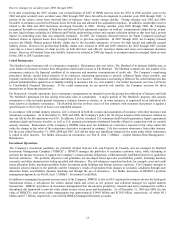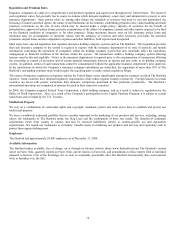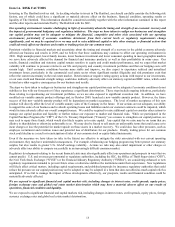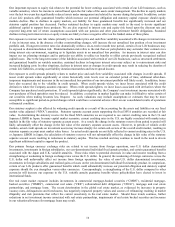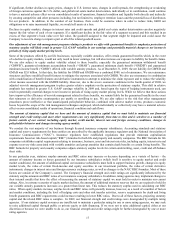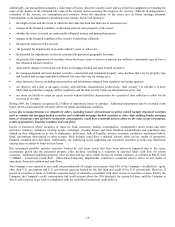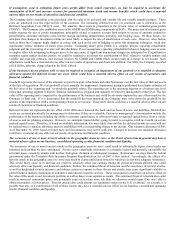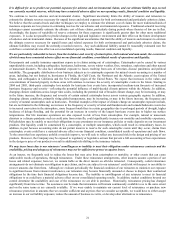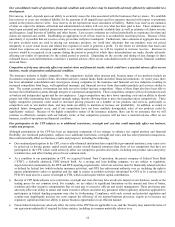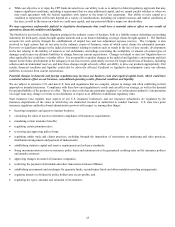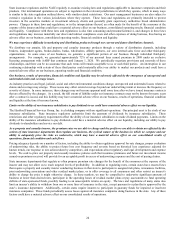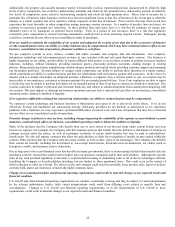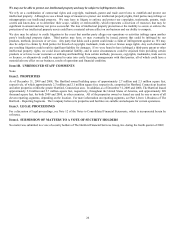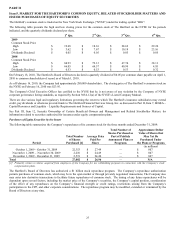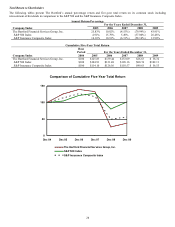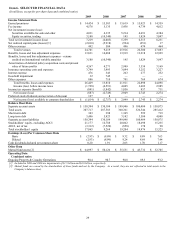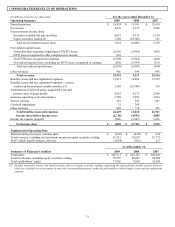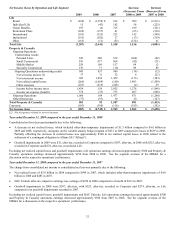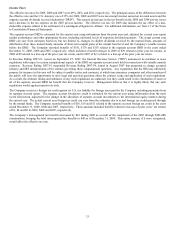The Hartford 2009 Annual Report Download - page 23
Download and view the complete annual report
Please find page 23 of the 2009 The Hartford annual report below. You can navigate through the pages in the report by either clicking on the pages listed below, or by using the keyword search tool below to find specific information within the annual report.
23
• While our objective is to repay the CPP funds invested in us, our ability to do so is subject to federal regulatory approvals that may
impose significant conditions, including a requirement that we raise additional capital, and we cannot predict whether or when we
may reach agreement with the federal regulators with respect to the terms of our repayment. Our ability to raise capital as a
condition to repayment will in turn depend on a variety of considerations, including our capital resources and market conditions at
the time, as well as the terms on which we could raise capital, and any potential dilutive impact on shareholders.
We may experience unfavorable judicial or legislative developments that could have a material adverse effect on our results of
operations, financial condition and liquidity.
The Hartford is involved in claims litigation arising in the ordinary course of business, both as a liability insurer defending or providing
indemnity for third-party claims brought against insureds and as an insurer defending coverage claims brought against it. The Hartford
accounts for such activity through the establishment of unpaid loss and loss adjustment expense reserves. The Company is also
involved in legal actions that do not arise in the ordinary course of business, some of which assert claims for substantial amounts.
Pervasive or significant changes in the judicial environment relating to matters such as trends in the size of jury awards, developments
in the law relating to the liability of insurers or tort defendants, and rulings concerning the availability or amount of certain types of
damages could cause our ultimate liabilities to change from our current expectations. Changes in federal or state tort litigation laws or
other applicable law could have a similar effect. It is not possible to predict changes in the judicial and legislative environment and their
impact on the future development of the adequacy of our loss reserves, particularly reserves for longer-tailed lines of business, including
asbestos and environmental reserves, and how those changes might adversely affect our ability to price our products appropriately. Our
results, financial condition and liquidity could also be adversely affected if judicial or legislative developments cause our ultimate
liabilities to increase from current expectations.
Potential changes in domestic and foreign regulation may increase our business costs and required capital levels, which could have
a material adverse effect on our business, consolidated operating results, financial condition and liquidity.
We are subject to extensive U.S. and non-U.S. laws and regulations that are complex, subject to change and often conflicting in their
approach or intended outcomes. Compliance with these laws and regulations is costly and can affect our strategy, as well as the demand
for and profitability of the products we offer. There is also a risk that any particular regulator’ s or enforcement authority’ s interpretation
of a legal issue may change over time to our detriment, or expose us to different or additional regulatory risks.
State insurance laws regulate most aspects of our U.S. insurance businesses, and our insurance subsidiaries are regulated by the
insurance departments of the states in which they are domiciled, licensed or authorized to conduct business. U.S. state laws grant
insurance regulatory authorities broad administrative powers with respect to, among other things:
• licensing companies and agents to transact business;
• calculating the value of assets to determine compliance with statutory requirements;
• mandating certain insurance benefits;
• regulating certain premium rates;
• reviewing and approving policy forms;
• regulating unfair trade and claims practices, including through the imposition of restrictions on marketing and sales practices,
distribution arrangements and payment of inducements;
• establishing statutory capital and reserve requirements and solvency standards;
• fixing maximum interest rates on insurance policy loans and minimum rates for guaranteed crediting rates on life insurance policies
and annuity contracts;
• approving changes in control of insurance companies;
• restricting the payment of dividends and other transactions between affiliates;
• establishing assessments and surcharges for guaranty funds, second-injury funds and other mandatory pooling arrangements;
• requiring insurers to dividend to policy holders any excess profits; and
• regulating the types, amounts and valuation of investments.


